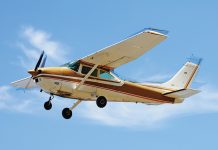Boeing 747-312 VH-INH
Sydney (Kingsford-Smith) Airport,
12:22 pm, 19 October 1994
Every accident, no matter how minor, is a failure of the organisation.
– Jerome F Lederer 1902–2004
Nobody was hurt but this crash exposed fundamental organisational flaws and skated close to the cliff edge between black comedy and tragedy.
When the Boeing 747 reached 31,000 feet, Kate McAuley thought the worst was over. A late connection meant she had nearly missed the flight that was now taking her to a new life in a new city, where a new husband was waiting for her. As Ansett flight 881 passed the approximate latitude of Coolangatta, 3 decades ago, heading north, she turned her thoughts to the future. Then came an interruption.
‘We were near Brisbane, when the pilot said in English that oil was leaking from an engine and we had to turn around – we couldn’t land in Brisbane because the plane was too heavy,’ McAuley says now, from the US.
‘I was angry because I wanted to start my new adventure. I was, ‘Like, whatever!’ I was only a teenager.’
For the next hour she was alone in her irritation. ‘I was surrounded by Japanese honeymooners – everyone happily taking videos and photographs.’ McAuley also watched the ‘beautiful, surreal horizontal waterfall’ of fuel being dumped from the Boeing 747’s wings.
‘About 15 minutes before we came into land, they translated the pilot’s announcement into Japanese and the cabin crew were rushing through the cabin making sure everyone had their seat belts on.’
Flight 881 returned to Sydney on a grey wet spring day on 3 engines and began a standard instrument approach from the West Pymble locator. The windscreen wipers were dancing as they emerged from cloud at 500 feet with Sydney’s then-single runway 16 ahead of them.
‘After we touched down, it felt like we were nose-high,’ McAuley remembers. ‘Then … the reports said the pilot gently laid the nose on the tarmac. That didn’t happen – it was very loud, a lot of careening and very bumpy, grinding noises and sliding left to right. It was not a pleasant experience.’

What happened
The aircraft had landed with its nose gear retracted. It was the first, and so far, the only time, a Boeing 747 has done this. Other 747 nose gear collapses have involved human error in maintenance, the wheels hitting approach lights or objects near the runway after a runway excursion.
On the way back to Sydney, the crew had briefed for the landing, including the possibility that gear extension would be slower. The captain was pilot monitoring, the first officer was pilot flying, and the flight engineer was intermittently busy replying to airline management by radio to arrange accommodation and onward flights for the passengers.
The gear had been lowered at 2,000 feet. The first sign of trouble was 50 seconds later when the flap lever was moved from 20 degrees to 25. The landing gear warning horn sounded which the captain rationalised as the gear being in transit. He moved the lever back to 20 degrees, thinking this would direct more hydraulic pressure to the gear. He asked the engineer to check the gear panel, to which the engineer replied, ‘Four greens.’ The captain later said he may have heard this as, ‘All greens.’ The crew were not using headsets.
At 500 feet, the captain asked the flight engineer if all green lights were on for both primary and secondary indicating systems. The flight engineer responded that they were. The captain said he was perplexed by the still-illuminated red gear warning light on the centre instrument panel. Seven seconds later, the flight engineer said the flaps were still running. The captain indicated he was still concerned about the landing gear warning horn, which indeed sounded until touchdown.
As the Boeing crossed the Alexandra Canal on the last stages of its descent, it was flying at 186 knots, a considerable 26 knots faster than the calculated reference speed for final approach (Vref). Observers saw ribbons of condensation trailing from its wings. As the crew were about to lower the nose, they heard from the tower that the nose gear had not deployed. There was a momentary consideration of a three-engine go-around, but this was quickly rejected and the crew let the nose settle to the runway.
As the crew were about to lower the nose, they heard from the tower that the nose gear had not deployed.
From the report
An unexplained reduction in air-driven hydraulic pump output caused slower than expected operation of the number one hydraulic system. The system may still have been capable of extending all the landing gear, given adequate time. However, the aircraft landed before the system could complete the landing gear extension. The flight crew had the opportunity to recognise and correct the landing gear problem prior to landing. The pilot in command attempted to determine the actual landing gear situation from the flight engineer. Although the flight engineer’s panel indicated the nose gear was not down and locked, the flight engineer did not recognise this and subsequent communication and coordination between the flight crew failed to detect this error.
Although the flight engineer’s panel indicated the nose gear was not down and locked, the flight engineer did not recognise this.
Why it happened: the technical picture
The Bureau of Air Safety Investigation (BASI), precursor of today’s Australian Transport Safety Bureau, investigated the crash. The bureau found that the oil loss was caused by the failure of a threaded insert used to retain the engine angle gearbox housing cover. A service bulletin for this precise issue, SB JT9D-7R4-72-410, had existed since 1990 but was not mandatory and neither Ansett nor the aircraft’s previous operator, Singapore Airlines, had actioned it.
The landing gear was normally driven by the hydraulic pump powered by the No 1 engine, as the flight crew knew. But, as one of the 747’s many design redundancies, a second identical pump was driven by a common manifold that took bleed air from all 4 engines. In the auto setting selected as part of the flight engineer’s checklist, this pump acted to maintain hydraulic pressure at or near 3,000 psi.
There had been 3 maintenance log entries in 4 weeks reporting problems with this number one air-driven hydraulic pump system, the most recent being 9 days before the crash. However, engineers were unable to replicate the fault. When the aircraft was test flown after the crash, the pump worked perfectly.
What allowed it to happen? The big picture
One false move and we could have a farce on our hands. – Tom Stoppard
The crash occurred at the perfect time in production schedules for newspapers and TV that dominated media in those days and Ansett suddenly had abundant if unwanted publicity for its new international route. The airline had begun international flights to Bali in 1993 and on 30 March 1994, its directors decided to expand operations to the new Kansai airport in Osaka, Japan. The first service was to be on the airport’s opening day, 4 September 1994. A project team took on the task’s many elements, but its manager left in July 1994.
Flight crew training quickly emerged as a problem area. An initial arrangement for Qantas to conduct line (operational flight) training was scuppered by industrial action. Two ex-Singapore Airlines’ Boeing 747s arrived in May, only for Qantas to withdraw from ground and simulator training, which it had expected would be linked to a lease of its Boeing 747s. The date for crew training commencement was pushed back by a month.
Contract crews were hired for a four-month term from September 1994 to January 1995. On 9 June after high-level discussions between Qantas and Ansett, simulator and ground training at Qantas were restored. At once there was a divergence of philosophies. Qantas recommended its training course, but Ansett preferred the Singapore Airlines version of the Boeing operations manual, amended to reflect Ansett practices. One such divergence was the role of the flight engineer. It was regarded as a technical specialist by Ansett but as an integral member of the crew by Qantas, whose flight engineers had specific duties of checking and monitoring, and a general role as a flight deck resource.
Training was intense and conducted at unusual hours when the simulators were available. The courses were confused and disorganised, with attendees reporting, ‘Unsigned, unattributed sheets of paper containing amendments to operational procedures were distributed to trainees during the night.’ One pilot reported knowing 3 different checklists, based on Qantas, Boeing/Singapore Airlines and Ansett procedures. Three pilots on the first course did not complete the program and overall final check failures were high: 6 of the 13 pilots and 2 of the 6 engineers failed their first simulator final check. The Qantas simulator had Rolls-Royce engines while the Ansett aircraft had Pratt & Whitney engines, requiring supplementary training, and unlearning of some simulator drills.
On 19 October, this roulette wheel of shortcomings and shortcuts by operator, regulator and crew came up short.
Nonetheless, Ansett’s inaugural Boeing 747 ‘spaceship’ flight to Kansai took off on 4 September and landed without incident.
The experience of the crew on the day of the incident was unevenly distributed and they had no common set of standard operating procedures between them.
- The contracted captain was highly experienced, with 21,500 hours, including 7,500 on type, recently retired from Cathay Pacific Airways.
- The first officer had 7,100 hours including 80 on type, all of it training. However, an illness meant the first officer had not undergone a line check before the flight.
- The flight engineer, one of 2 who had failed their final simulator check, was on their first revenue flight on type.
BASI listed other significant local factors which influenced the performance of the flight crew:
- cockpit noise levels – high
- subtle pressures – management suggested the crew ‘turn around’ to fly the replacement flight in another aircraft.
- flight engineer’s lack of preparedness for the task
- flight engineer’s panel skills
- task overload
- layout of the flight engineer’s panel – there was no grouping of the 5 gear lights
- crew resource management – was not required by the regulator at the time
- stabilised approach procedures – were not followed.
Oversight by the then regulator, the Civil Aviation Authority, had been flawed. Line training oversight was managed from the Sydney office while Boeing 747 introduction was managed from Melbourne. And the authority ignored concerns raised by its own specialist 747 pilot.
On 19 October, this roulette wheel of shortcomings and shortcuts by operator, regulator and crew came up short. Another way to think of it would be as the holes inevitably lining up in a series of notably porous Swiss cheese slices.
Postscript: the next day
After the longest 15 minutes of her life, McAuley was evacuated, anticlimactically, via stairs and bus. She was given a cup of tea as disaster victim support and called her mother on a huge, heavy device known as a mobile phone.
She naively thought she might have to pay for the minibar in the hotel Ansett booked for her. The next day, when asked if she wanted to fly again, she surprised the staff by saying ‘Sure!’ – and was allocated the same seat on another 747.
The seat came with a free and unsettling serve of déjà vu. ‘Once we got past Brisbane, I thought ‘OK, it’s really happening – I’m on my way’.’






Comments are closed.